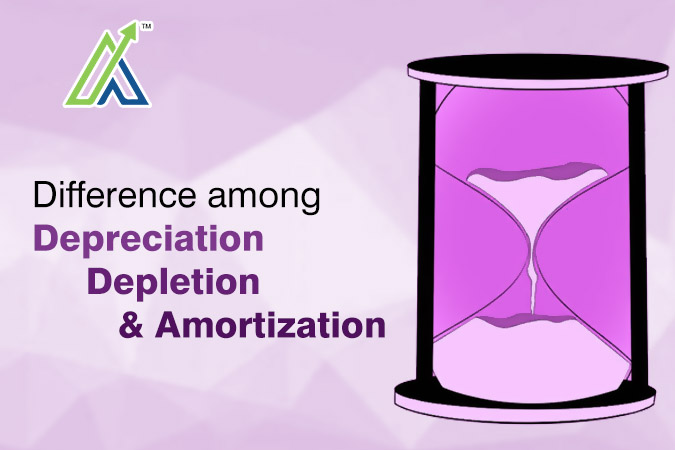In the case of the Indian financial system, one very often comes across three financial accounting terms: ‘Depreciation’, ‘Depletion’, and ‘Amortisation’. All three, therefore, hold great importance for any business to correctly access its assets and financial position. Though each of these three elements might seem similar to a standalone observer, it is quite different in application to different types of assets.
Depreciation
Depreciation is the cost allocated to tangible fixed assets throughout the useful life of the asset, in a systematic manner. It is thus subtracted to consider the reduction in value in the useful life from physical wear and tear or decay, or even obsolescence of assets like machinery, equipment, buildings, and vehicles.
Example: An Indian mining company invests ₹50,00,000 to acquire a coal mine estimated to contain 1,00,000 tonnes of coal. The depletion expense per tonne is calculated as:
Depletion Expense per tonne = Cost of Mine/Total Estimated Reserves
50,00,000/1,00,000 =50Rs.
If the company extracts and sells 10,000 tonnes of coal in a year, the depletion expense for that year would be:
Annual Depletion Expense = 10,000 tonnes * Rs.50 per tonne = Rs.5,00,000
This expense is recorded in the financial statements to reflect the decreasing value of the natural resource asset.
Amortization
Amortization is the process of prorating the cost of intangible assets over their useful life periods. Intangible assets to which amortization applies include patents, copyrights, trademarks, franchises, and goodwill. The process is quite similar to depreciation, where the value of an intangible asset is systematically written off over the periods that benefit from the use of the intangible asset in the creation of revenues.
Example: An Indian pharmaceutical company acquires a patent for ₹20,00,000, which has a legal life of 20 years. Assuming the patent is expected to provide economic benefits evenly over its life, the annual amortization expense would be:
Annual Amortization Expense = Cost of Patent/Useful life
Rs.20,00,000/20 = 1,00,000
This annual expense of ₹1,00,000 is recorded in the income statement, and the value of the patent is reduced accordingly on the balance sheet.
Depletion
Depletion is just one cost-allocation mechanism of the extracting of natural resources, such as minerals, oil, and natural gas, timber, etc., over the life of consumption of that asset. This applies to any industry engaged in extracting such resources, whether it is mining, oil drilling, or forestry.
Example: An Indian mining company invests ₹50,00,000 to acquire a coal mine estimated to contain 1,00,000 tonnes of coal. The depletion expense per tonne is calculated as:
Depletion Expense per Tonne = Cost of Mine/Total Estimated Reserves
₹50,00,000/1,00,000 tonnes = ₹50 per tonne
If the company extracts and sells 10,000 tonnes of coal in a year, the depletion expense for that year would be:
Annual Depletion Expense = 10,000 tonnes×₹50 per tonne=₹5,00,000
This expense is recorded in the financial statements to reflect the decreasing value of the natural resource asset.
Key Differences in Depreciation, Depletion, and Amortization
| Aspect | Depreciation | Depletion | Amortization |
|---|---|---|---|
| Nature of Assets | Tangible fixed assets (e.g., machinery, buildings) | Natural resources (e.g., minerals, oil, gas) | Intangible assets (e.g., patents, copyrights) |
| Method of Calculation | Examples include straight-line, reducing balance, and units of production | Generally computed based on the unit of production or the cost depletion | Usually follows the straight-line method |
| Example | A machine purchased for ₹10,00,000 with a useful life of 10 years and a residual value of ₹1,00,000. Annual depreciation expense = ₹90,000 | A coal mine purchased for ₹50,00,000 with 1,00,000 tonnes of coal. Depletion expense per tonne = ₹50 | A patent acquired for ₹20,00,000 with a useful life of 20 years. Annual amortization expense = ₹1,00,000 |
| Impact on Financial Statements | It reduces the book value of tangible fixed assets over time | Depletes the book value of natural resource reserves as they are extracted | Decreases the book value of an intangible asset over the course of its useful life |
| Reporting Requirement | Necessary for high-quality financial reports and following accounting standards | Reflects Consumed natural resources recorded in financial statements | Ensures that the use of an intangible asset is reported in the financial report. |
jhh
Question to test your Understanding
Question 1: Which of the following terms refers to the cost allocation for tangible fixed assets throughout their useful life?
- Depletion
- Depreciation
- Amortization
- Devaluation
Question 2: Amortization divides the cost of which type of assets over their useful life periods?
- Tangible fixed assets
- Natural resources
- Intangible assets
- Inventory
Question 3: Depletion is mainly related with which of the following types of assets?
- Machinery and equipment
- Buildings and vehicles
- Patents and copyrights
- Natural resources
Question 4: Which methods is used commonly for calculating depletion?
- Straight-line method
- Reducing balance method
- Unit of production or cost depletion
- Double declining balance method
Question 5: Impact of depreciation on financial statements by:
- Over time reducing the book value of intangible assets
- Depletion in the book value of natural resource reserves as they are extracted
- Over time reducing the book value of tangible fixed assets
- Increasing the value of inventory
Conclusion
Correct financial reporting and effective management of these assets in the Indian financial system depend on a correct knowledge of the various nuances of depreciation, depletion, and
amortization. With these differing purposes, businesses can allocate their costs in a systematic way and keep a clear picture regarding their financial health. Among these, business differentiation would provide a plan for future investment and transparently report their resources to each stakeholder.

